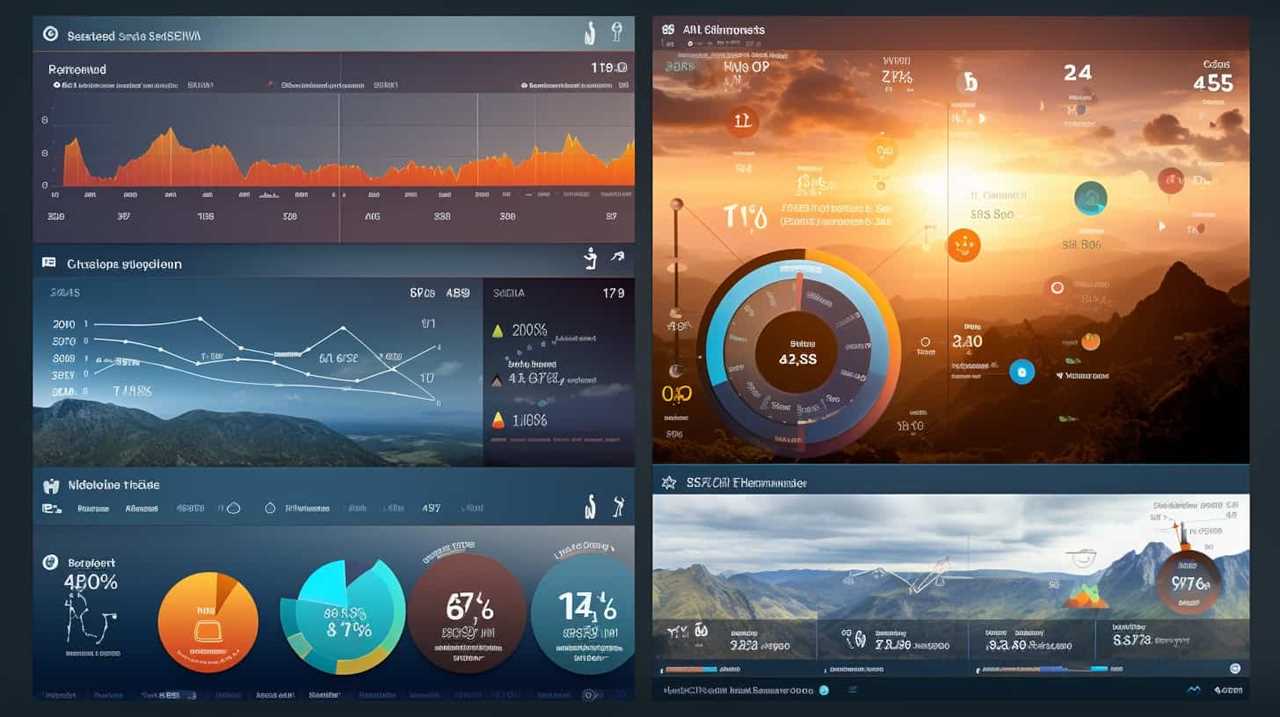How Yahoo’s directory system organized and categorized online content, distinguishing it from other search engines.
Discussion ideas:
- The impact of personalized search results on user experience.
- The role of artificial intelligence in creating a unique search engine personality
We remember a time when Google wasn’t the go-to search engine. Before the era of Google dominance, there were other players in the game, each with its own unique features and strengths.
Yahoo, AltaVista, Ask Jeeves, Lycos, Excite, HotBot, WebCrawler, and Dogpile all had their moments in the spotlight.

In this article, we will explore the search engines that preceded Google and paved the way for the digital landscape we know today.
Key Takeaways
- Yahoo, AltaVista, Ask Jeeves, and Lycos were notable search engines before Google.
- Web directories, like the one offered by Lycos, played a crucial role in web navigation before Google.
- Lycos revolutionized web navigation with its introduction of web directories and provided an organized approach to web exploration.
- Lycos’s search algorithm considered keyword analysis, page popularity, content analysis, user behavior, and freshness factor for search relevance.
Yahoo: The Internet Pioneer
Before Google, Yahoo was the search engine that we relied on for finding information on the internet. In the early days of the web, Yahoo emerged as a pioneer, competing with other search engines like Lycos. Lycos was a popular search engine known for its comprehensive directory-style approach to organizing web content. However, Yahoo quickly gained popularity due to its user-friendly interface and innovative search technology.
One such technology was HotBot, an advanced search engine developed by Wired Digital. HotBot introduced features like Boolean operators and advanced search filters, allowing users to refine their search results with precision. This made Yahoo a go-to choice for internet users in search of accurate and relevant information.
Yahoo’s competition with Lycos and the introduction of HotBot’s innovative search technology contributed to Yahoo’s success as a leading search engine before the rise of Google.

AltaVista: The Powerhouse of the 90s
What made AltaVista the powerhouse of the 90s?
AltaVista’s success can be attributed to its advanced search algorithm and its ability to navigate the web in a way that was unprecedented at the time. Unlike other search engines such as Lycos, AltaVista utilized a more sophisticated algorithm that allowed for more accurate and relevant search results.
This, combined with its efficient web crawling capabilities, made AltaVista the go-to search engine for internet users in the 90s. AltaVista’s dominance was also fueled by its user-friendly interface, which made it easy for users to find the information they were looking for.
However, despite its initial success, AltaVista was eventually overshadowed by the rise of Google, which introduced a more efficient and streamlined search experience.

This transition will be further explored in the subsequent section about ‘Ask Jeeves: The Search Engine with Personality’.
Ask Jeeves: the Search Engine With Personality
Ask Jeeves was a search engine with a unique personality that set it apart from other search engines of its time. Despite not being as popular as some of its competitors, Ask Jeeves made a significant impact on the search industry.
Here are some of its notable features:
- Natural language search: Ask Jeeves allowed users to type questions in plain English, making it easier to find relevant information.
- Jeeves, the butler: The search engine had a mascot named Jeeves, a butler character who’d provide search results and suggestions.
- Human-powered directory: Ask Jeeves had a team of editors who reviewed and categorized websites, offering a curated directory alongside its search results.
- Targeted advertising: The search engine introduced targeted advertising, tailoring ads based on users’ search queries.
- Multimedia search: Ask Jeeves incorporated webcrawler’s unique features, allowing users to search for images and videos alongside text-based results.
Ask Jeeves’s distinctive approach to search paved the way for future advancements in natural language processing and personalized search experiences.

Now, let’s delve into another popular search engine of the pre-Google era, Lycos: the gateway to the web.
Lycos: The Gateway to the Web
Lycos, one of the pioneering search engines, had a significant impact on the way we search and navigate the web before Google dominated the scene.
With its powerful search algorithm, Lycos became the gateway to the web for many users, helping them find relevant information quickly and efficiently.
Its user-friendly interface and advanced features made it a popular choice among internet users in the early days of the internet.

Lycos’s Impact on Search
Lycos significantly shaped the landscape of online search, serving as a pivotal gateway to the vast expanse of the World Wide Web. During its prime, Lycos was a dominant player in the search engine market, competing fiercely with other major search engines such as Yahoo, AltaVista, and Excite.
Lycos’s impact on search can be summarized in the following points:
- Comprehensive search results: Lycos indexed a vast amount of web pages, providing users with a wide range of search results.
- Advanced search features: Lycos introduced advanced search options, allowing users to refine their searches based on specific criteria.
- Multimedia search: Lycos pioneered multimedia search, enabling users to find images, videos, and audio files.
- Web portal integration: Lycos integrated search functionality into its web portal, offering users a one-stop destination for news, email, and other online services.
- Lycos’s downfall: Despite its initial success, Lycos eventually faced challenges from emerging search engines like Google, leading to its decline in popularity.
Web Navigation Pre-Google
Before Google, web navigation was significantly impacted by Lycos, serving as the gateway to the web. In the early days of the internet, web directories played a crucial role in helping users find information online.
Lycos was one of the pioneers in this field, offering a comprehensive directory of websites organized by categories. Unlike search engines that rely on algorithms to index and rank web pages, Lycos used manual indexing. This meant that a team of editors carefully reviewed and categorized each website, ensuring a high level of accuracy and relevance.

Users could navigate through the directory, browsing different categories and subcategories to find the information they were looking for. Lycos’s web directory provided a structured and organized approach to web navigation, making it easier for users to explore the vast expanse of the internet.
Lycos’s Search Algorithm
We explored the impact of Lycos on web navigation, and now we’ll delve into the workings of its search algorithm. Lycos’s search algorithm played a crucial role in determining search relevance and ranking factors. Here are the key aspects of Lycos’s search algorithm:
- Keyword analysis: Lycos’s algorithm analyzed the keywords used in web pages to determine their relevance to a search query.
- Page popularity: The algorithm considered the popularity of a web page by analyzing the number and quality of incoming links.
- Content analysis: Lycos’s algorithm evaluated the content of a web page to determine its relevance to a search query.
- User behavior: The algorithm took into account user behavior, such as click-through rates and time spent on a page, to gauge its relevance.
- Freshness factor: Lycos’s algorithm considered the freshness of the content, giving priority to recently updated pages.
Excite: The Portal to the Digital World
Excite revolutionized the way we accessed and explored the digital world. As Lycos’s competition, Excite offered a range of unique features that set it apart from other search engines of its time.
One of its notable features was personalized search results. Excite allowed users to create personalized profiles, which helped tailor search results to their specific interests and preferences.

Additionally, Excite introduced the concept of a web portal, providing users with a centralized platform to access various online services and content. This included email, news, weather, and more.
Excite also integrated multimedia content, such as images and videos, into its search results, enhancing the overall user experience.
With these innovative features, Excite played a significant role in shaping the way we interacted with and consumed digital information.
HotBot: The Sleek and Powerful Search Engine
HotBot, a search engine that was popular in the late 1990s, continues to have an impact today. With its sleek interface and powerful search capabilities, HotBot stood out among its competitors for its user-friendly design.

Users appreciated its advanced features, such as the ability to search for images and news articles.
Hotbot’s Impact Today
HotBot revolutionized the search engine industry with its sleek and powerful features, leaving a lasting impact that’s still felt today. Here is a look at HotBot’s influence on modern search technology and the rise and fall of HotBot in the search engine market:
- Advanced Search Capabilities: HotBot introduced advanced search options, allowing users to refine their searches with greater precision.
- Multimedia Search: HotBot was one of the first search engines to incorporate multimedia search, enabling users to find images, videos, and audio files.
- Privacy Features: HotBot prioritized user privacy by offering a secure search option and protecting personal information.
- International Expansion: HotBot expanded its services globally, catering to a wider audience and contributing to the growth of the search engine market worldwide.
- Competition with Google: Despite its initial success, HotBot faced tough competition from Google, leading to its decline in the search engine market.
HotBot’s impact on search technology paved the way for sleeker and more powerful interfaces, which will be discussed in the subsequent section.
Sleek Vs. Clunky Interfaces
When comparing search engines before Google, it becomes evident that HotBot stood out with its sleek and powerful interface. HotBot’s sleek design and intuitive user experience set it apart from its clunky counterparts.

The clean and minimalist layout allowed users to navigate effortlessly and find the information they needed quickly. The search results were presented in a visually appealing manner, making it easier for users to scan and locate relevant content.
HotBot’s interface was designed with the user in mind, prioritizing simplicity and ease of use. This attention to detail enhanced the overall search experience and set the standard for future search engines.
HotBot’s sleek interface was a game-changer, demonstrating that a search engine could be both powerful and visually appealing.
Hotbot’s Advanced Features?
Continuing with our comparison of search engines before Google, let’s explore the advanced features that set HotBot apart as a sleek and powerful search engine.

HotBot gained popularity due to its innovative features and significant impact on the search engine industry.
Here are some of HotBot’s advanced features:
- Advanced search syntax: HotBot allowed users to refine their search queries using operators such as AND, OR, and NOT, enabling more precise results.
- Language support: HotBot supported multiple languages, making it accessible to a global audience.
- Multimedia search: HotBot introduced a feature that allowed users to search for images, videos, and audio files, providing a more comprehensive search experience.
- Customizable interface: HotBot allowed users to customize their search preferences, including the number of results displayed per page and the ability to filter content.
- Privacy options: HotBot offered privacy features such as the ability to disable tracking and clear search history, ensuring user privacy and control over their data.
HotBot’s advanced features, coupled with its user-friendly interface, made it popular among internet users and had a significant impact on the search engine industry.
WebCrawler: The Early Crawler-Based Search Engine
WebCrawler was an early crawler-based search engine that revolutionized the way we accessed information online. In the early days of the internet, search engines like Lycos and WebCrawler were competing to become the go-to search tool.

While Lycos relied on human-edited directories, WebCrawler utilized a crawler-based approach, which allowed it to index and retrieve results from a larger number of websites. This gave WebCrawler an advantage in terms of the breadth and depth of its search results.
Additionally, WebCrawler’s influence on future search engines can’t be overstated. Its innovative crawling technology laid the foundation for many of the search engines that followed, including Google.
WebCrawler’s success demonstrated the power of automated web indexing and paved the way for the modern search engine landscape.
Dogpile: The Meta Search Engine Solution
Moving forward in our exploration of search engines before Google, let’s now delve into Dogpile: The Meta Search Engine Solution.

Dogpile was introduced in 1996 and quickly gained popularity due to its unique approach to search. Here are some key features of Dogpile:
- Meta Search: Dogpile combined results from multiple search engines, including Lycos, and presented them in a single page. This allowed users to access a wider range of information efficiently.
- Eliminating Duplicate Results: Dogpile had an algorithm that removed duplicate listings from different search engines, ensuring a more streamlined search experience.
- Advanced Search Options: Dogpile offered advanced search options, including image and video search, making it ahead of its time.
- Customizable Interface: Users could personalize their Dogpile experience by selecting their preferred search engines and adjusting the layout.
- Privacy Protection: Dogpile prioritized user privacy by not storing any personally identifiable information.
Dogpile’s unique approach and integration with Lycos played a significant role in diversifying the search engine market and providing users with a comprehensive search solution.
Frequently Asked Questions
What Were the Specific Features That Set Yahoo Apart From Other Search Engines During Its Early Days as an Internet Pioneer?
During its early days as an internet pioneer, Yahoo stood out from other search engines with its specific features. One key feature was its directory system, which effectively organized and categorized web content, setting it apart and contributing to its success in the market.
How Did Altavista Manage to Dominate the Search Engine Market During the 90s?
During the 90s, Altavista managed to dominate the search engine market by implementing a highly advanced search algorithm. However, its reign was short-lived as Google emerged with superior features, leading to a comparison between Altavista and Google.

What Made Ask Jeeves Unique Compared to Other Search Engines, and How Did It Incorporate Personality Into Its Search Results?
Ask Jeeves incorporated unique features by incorporating personality into its search results. This added a human touch to the search experience, making it stand out from other search engines before Google.
In What Ways Did Lycos Serve as a Gateway to the Web for Users?
Lycos served as a gateway to the web, revolutionizing our online experience. Its user-friendly interface and comprehensive search capabilities impacted internet usage by providing easy access to a vast array of information.
What Differentiated Excite From Other Search Engines of Its Time, and How Did It Establish Itself as a Portal to the Digital World?
Differentiation strategies and the digital revolution allowed Excite to establish itself as a portal to the digital world. It distinguished itself from other search engines of its time by offering a comprehensive range of services and a user-friendly interface.
Conclusion
In conclusion, exploring the search engines that came before Google offers a glimpse into the evolution of the digital landscape.

Just like a time traveler observing the development of technology, we can appreciate the pioneering efforts of Yahoo, the powerhouse status of AltaVista, and the personality of Ask Jeeves.
These search engines paved the way for Google’s dominance, shaping the internet as we know it today.
It’s fascinating to witness the journey from the early crawler-based WebCrawler to the sleek and powerful HotBot, ultimately culminating in the meta search engine solution of Dogpile.










